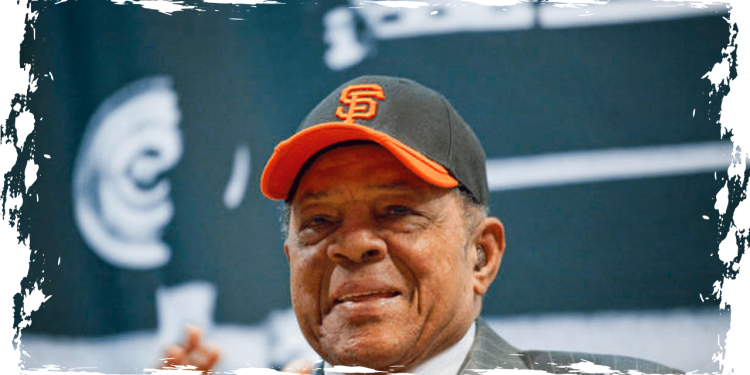The San Francisco Giants have announced the passing of Willie Mays, the legendary baseball icon whose incredible career spanned over 22 seasons. At the age of 93, Mays has left a lasting legacy on the sport and its fans.
In a statement released by the Giants, it was announced that Mays had passed away peacefully this afternoon.
Major League Baseball Commissioner Rob Manfred issued a statement on Tuesday evening, expressing his condolences as the entire organization mourns the loss of a legendary figure. The very ballpark where Willie Mays began his remarkable career and legacy is now the site of solemn remembrance. Mays showcased his all-around brilliance as a player for the Birmingham Black Barons of the Negro American League before joining the historic Giants franchise. His influence spanned the nation, inspiring generations of players and fans alike as baseball grew and became our beloved National Pastime.
In a statement released on Monday, Mays expressed his regret for not being able to attend the special tribute game of the Giants against the St. Louis Cardinals on Thursday. The game will be held at Rickwood Stadium in Birmingham, Alabama, to honor Mays and the Birmingham Black Barons of the Negro Leagues, where he started his professional career back in 1948.
On Thursday, the MLB announced that the game will feature a pregame ceremony to pay tribute to the life of Willie Mays.
Known as the “Say Hey Kid,” Mays dedicated most of his career to patrolling center field for the Giants, starting in New York and later after the team’s relocation to San Francisco. In the 1954 World Series, while playing in Game 1, Mays executed what is now famously referred to as “The Catch” – a remarkable over-the-shoulder catch of a fly ball that is widely regarded as the most exceptional catch ever made in baseball history.
Mays became an instant cultural icon and remained so thereafter.
Growing up in Westfield, Alabama, Mays was introduced to the game of baseball at a young age by his father, Cat Mays. Despite being a single dad and working as a steelworker, Cat found the time to teach his son the ins and outs of the game he himself had dreamed of playing professionally. Playing on the local steel mill’s baseball team, Cat passed down his passion for the sport to his son.
Mays’ baseball career took off at the young age of 16, when he became a member of the Birmingham Black Barons. In 1951, right after he graduated from high school, he was recruited by the New York Giants.
During his induction ceremony into the Hall of Fame in 1979, Mays shared the memories of his arrival in New York City on a Friday at 4 o’clock. He reminisced feeling petrified with only three bats in his tiny briefcase and his glove, without a uniform or a hat.
After his first season, Mays quickly found his footing and was awarded the National League Rookie of the Year title.
During the Korean War in 1952, the Army drafted him, interrupting his career. He was stationed at Fort Eustice in Virginia where he spent the majority of his time playing on military baseball teams, as reported by the Society for American Baseball Research.
In March of 1954, he was released from duty and returned to the Giants just in time for their victorious season. It was during this championship season that he received his first of two MVP awards.
In 1958, he relocated with his team to San Francisco where he continued to make significant strides. He led his team to the World Series championship in 1962, although they eventually lost to the New York Yankees in seven games. By 1964, he had become the captain of the team, further cementing his leadership role. In 1965, he won his second MVP award, a testament to his exceptional performance on the field.
In 1972-73, Mays was traded to the New York Mets, marking the end of his career.
With a total of 660 home runs, he secured the sixth spot in the list of all-time most home runs achieved by a player, marking the end of his remarkable playing career.
With 12 Golden Glove awards under his belt, he was a 24-time All-Star, which is tied for the second most of all time.
When Mays became eligible for the Hall of Fame in 1979, he was inducted on the first ballot with an overwhelming 97% of the vote. His outstanding career in baseball undoubtedly earned him the honor of being a Hall of Famer.
Throughout his lifetime, even after being traded from the Giants, Willie Mays held a special place in the San Francisco clubhouse. His visits to the clubhouse served as a source of inspiration for younger players.
In the year 2000, a significant statue was built outside Oracle Park to commemorate his legacy. The statue is encircled by 24 palm trees, paying tribute to his iconic number 24, which was retired by the organization. Despite not being fond of the title, he was widely considered as the greatest living baseball legend, and the statue serves as a humble reminder of his remarkable achievements.
Back in 2011, he expressed his disapproval towards the term “living ball player”. “If you’re the greatest ballplayer, you should be acknowledged as such, not just the ‘living’ one,” he stated. He questioned the significance of being recognized only after passing away. “When I first heard it, I was taken aback. Does that mean I have to be gone before you guys give me credit for my achievements?”
Over the years, Mays’ remarkable blend of speed, power, and defensive skills has earned him the title of the greatest baseball player of all time, whether living or dead.










